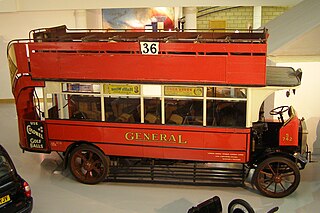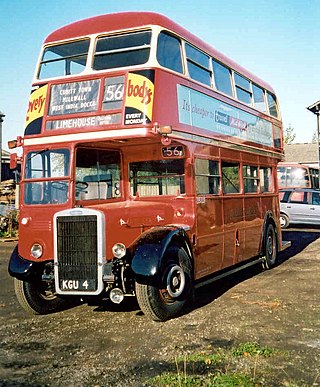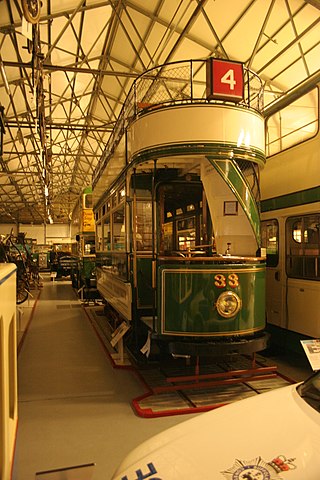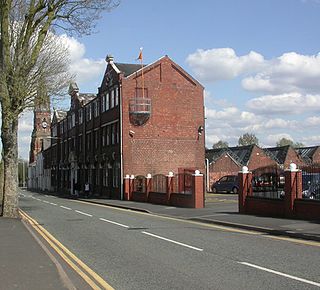
The London General Omnibus Company or LGOC, was the principal bus operator in London between 1855 and 1933. It was also, for a short period between 1909 and 1912, a motor bus manufacturer.

The Leyland Titan was a forward-control chassis with a front-mounted engine designed to carry double-decker bus bodywork. It was built mainly for the United Kingdom market between 1927 and 1942, and between 1945 and 1969.

Duple Coachbuilders was a coach and bus bodybuilder in England from 1919 until 1989.

The Leyland Olympian was a 2-axle and 3-axle double-decker bus chassis manufactured by Leyland between 1980 and 1993. It was the last Leyland bus model in production.

Guy Motors was a Wolverhampton-based vehicle manufacturer that produced cars, lorries, buses and trolleybuses. The company was founded by Sydney S. Guy (1885–1971) who was born in Kings Heath, Birmingham. Guy Motors operated out of its Fallings Park factory from 1914 to 1982, playing an important role in the development of the British motor industry.

The LGOC B-type is a model of double-decker bus that was introduced in London in 1910. It was both built and operated by the London General Omnibus Company (LGOC).
The LGOC X-type is an early model of London double-decker bus.

The AEC Q-type is an AEC-built, side-mounted-engine, single- and double-decker bus that was launched in 1932.

The AEC Regent III RT was one of the variants of the AEC Regent III. It was a double-decker bus produced jointly between AEC and London Transport. It was the standard red London bus in the 1950s and continued to outnumber the better-known Routemaster throughout the 1960s.

Charles H Roe was a Yorkshire coachbuilding company. It was for most of its life based at Crossgates Carriage Works, in Leeds.

Bristol Commercial Vehicles was a vehicle manufacturer located in Bristol, England. Most production was of buses but trucks and railbus chassis were also built.
A lowbridge double-deck bus is a double-decker bus that has an asymmetric interior layout, enabling the overall height of the vehicle to be reduced compared to that of a conventional double-decker bus. The upper deck gangway is offset to one side of the vehicle, normally the offside, and is sunken into the lower deck passenger saloon. Low railway bridges and overpasses are the main reason that a reduced height is desired.

The Daimler Fleetline is a rear-engined double-decker bus chassis which was built between 1960 and 1983.

The Ipswich Transport Museum is a museum in Ipswich, Suffolk, England, devoted principally to the history of transport and engineering objects made or used in its local area.

The East Lancs 1984-style double-deck body is a type of double-decker bus body with a step-entrance, built on several different chassis by East Lancashire Coachbuilders in England.

Thames Valley Traction Company Limited was a major bus company operating services to and from Reading, Bracknell, Maidenhead, Newbury, High Wycombe and Oxford and surrounding areas for 52 years in the 20th century. For many years it ran the "Reading A" and "Reading B" limited-stop services between London's Victoria Coach Station and Reading via two differing sets of intermediate stops.

Bus manufacturing, a sector of the automotive industry, manufactures buses and coaches.

The Volvo B5LH is a low-floor hybrid electric bus chassis for both single-decker buses and double-decker buses manufactured by Volvo since 2008. It is the basis for Volvo's integral 7700 Hybrid full low floor city bus and its successor, the 7900 Hybrid from 2011. In 2008, pre-production batches of both types of chassis were manufactured. Serial production started in June 2010. From 2013 it is also available as an articulated bus chassis. First entering service in London, the B5LH is the only current double decker type in service in the United Kingdom that uses a parallel hybrid drive system.

Sunbeam Commercial Vehicles was a commercial vehicle manufacturing offshoot of the Wolverhampton based Sunbeam Motor Car Company when it was a subsidiary of S T D Motors Limited. Sunbeam had always made ambulances on modified Sunbeam car chassis. S T D Motors chose to enter the large commercial vehicle market in the late 1920s, and once established they made petrol and diesel buses and electrically powered trolleybuses and milk floats. Commercial Vehicles became a separate department of Sunbeam in 1931.

















